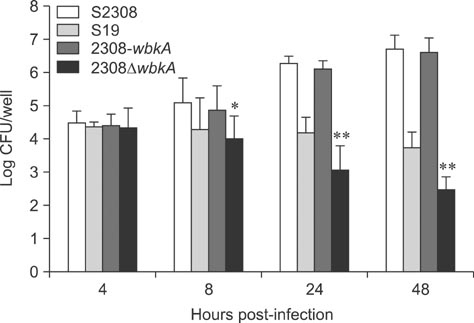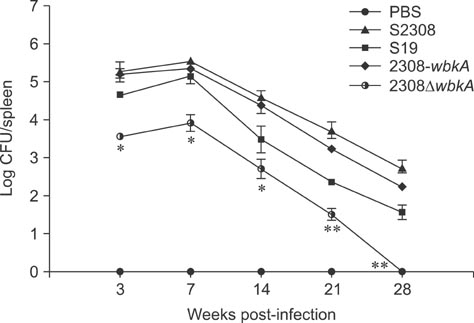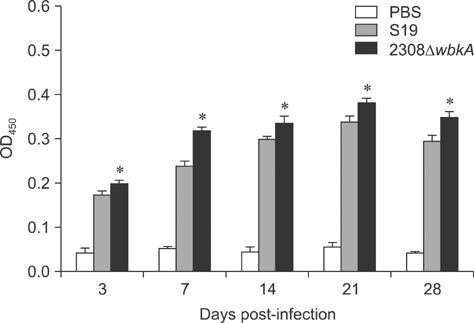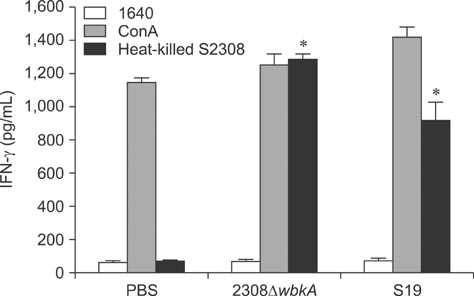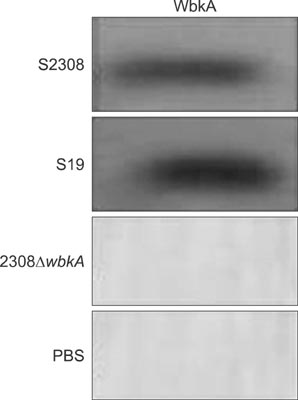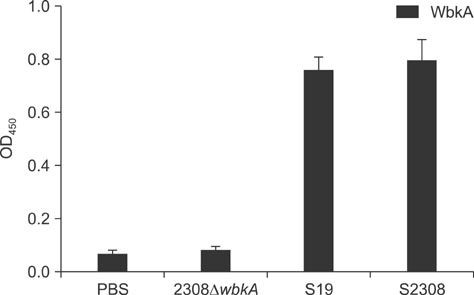J Vet Sci.
2015 Dec;16(4):467-473. 10.4142/jvs.2015.16.4.467.
Immunization of BALB/c mice with Brucella abortus 2308DeltawbkA confers protection against wild-type infection
- Affiliations
-
- 1College of Animal Science and Technology, Shihezi University, Shihezi 832000, China. allanzhh@sohu.com
- 2School of life sciences, Shangqiu normal university, Shangqiu 476000, China.
- 3College of Biology, Agriculture and Forestry, Tongren University, Tongren 554300, China.
- 4Co-Innovation Center for Zoonotic Infectious Diseases in the Western Region, Shihezi University, Shihezi 832000, China.
- 5College of Medicine, Shihezi University, Shihezi 832000, China.
- KMID: 2133629
- DOI: http://doi.org/10.4142/jvs.2015.16.4.467
Abstract
- Brucellosis is a zoonotic disease that causes animal and human diseases. Vaccination is a major measure for prevention of brucellosis, but it is currently not possible to distinguish vaccinated animals from those that have been naturally infected. Therefore, in this study, we constructed the Brucella (B.) abortus 2380 wbkA mutant (2308DeltawbkA) and evaluated its virulence. The survival of 2308DeltawbkA was attenuated in murine macrophage (RAW 264.7) and BALB/c mice, and it induced high protective immunity in mice. The wbkA mutant elicited an anti-Brucella-specific immunoglobulin G response and induced the secretion of gamma interferon. Antibodies to 2308DeltawbkA could be detected in sera from mice, implying the potential for use of this protein as a diagnostic antigen. The WbkA antigen would allow serological differentiation between infected and vaccinated animals. These results suggest that 2308DeltawbkA is a potential attenuated vaccine against 16M. This vaccine will be further evaluated in sheep.
Keyword
MeSH Terms
Figure
Cited by 1 articles
-
Interaction between Brucella melitensis 16M and small ubiquitin-related modifier 1 and E2 conjugating enzyme 9 in mouse RAW264.7 macrophages
Jihai Yi, Yueli Wang, Qifeng Li, Huan Zhang, Zhiran Shao, XiaoYu Deng, Jinke He, Chencheng Xiao, Zhen Wang, Yong Wang, Chuangfu Chen
J Vet Sci. 2019;20(5):. doi: 10.4142/jvs.2019.20.e54.
Reference
-
1. Adone R, Ciuchini F, Marianelli C, Tarantino M, Pistoia C, Marcon G, Petrucci P, Francia M, Riccardi G, Pasquali P. Protective properties of rifampin-resistant rough mutants of Brucella melitensis. Infect Immun. 2005; 73:4198–4204.
Article2. Ashford DA, di Pietra J, Lingappa J, Woods C, Noll H, Neville B, Weyant R, Bragg SL, Spiegel RA, Tappero J, Perkins BA. Adverse events in humans associated with accidental exposure to the livestock brucellosis vaccine RB51. Vaccine. 2004; 22:3435–3439.
Article3. Bercovich Z. The use of skin delayed-type hypersensitivity as an adjunct test to diagnose brucellosis in cattle: a review. Vet Q. 2000; 22:123–130.
Article4. Berkelman RL. Human illness associated with use of veterinary vaccines. Clin Infect Dis. 2003; 37:407–414.
Article5. Cardoso PG, Macedo GC, Azevedo V, Oliveira SC. Brucella spp noncanonical LPS: structure, biosynthesis, and interaction with host immune system. Microb Cell Fact. 2006; 5:13.6. Crasta OR, Folkerts O, Fei Z, Mane SP, Evans C, Martino-Catt S, Bricker B, Yu G, Du L, Sobral BW. Genome sequence of Brucella abortus vaccine strain S19 compared to virulent strains yields candidate virulence genes. PLoS One. 2008; 3:e2193.7. Davis DS, Elzer PH. Brucella vaccines in wildlife. Vet Microbiol. 2002; 90:533–544.8. Delrue RM, Lestrate P, Tibor A, Letesson JJ, De Bolle X. Brucella pathogenesis, genes identified from random large-scale screens. FEMS Microbiol Lett. 2004; 231:1–12.9. Goel D, Bhatnagar R. Intradermal immunization with outer membrane protein 25 protects Balb/c mice from virulent B. abortus 544. Mol Immunol. 2012; 51:159–168.
Article10. Golding B, Scott DE, Scharf O, Huang LY, Zaitseva M, Lapham C, Eller N, Golding H. Immunity and protection against Brucella abortus. Microbes Infect. 2001; 3:43–48.11. Grilló MJ, Manterola L, de Miguel MJ, Muñoz PM, Blasco JM, Moriyón I, López-Goñi I. Increases of efficacy as vaccine against Brucella abortus infection in mice by simultaneous inoculation with avirulent smooth bvrS/bvrR and rough wbkA mutants. Vaccine. 2006; 24:2910–2916.
Article12. Haag AF, Myka KK, Arnold MF, Caro-Hernández P, Ferguson GP. Importance of lipopolysaccharide and cyclic β-1,2-glucans in Brucella-mammalian infections. Int J Microbiol. 2010; 2010:124509.13. Hernández-Castro R, Verdugo-Rodríguez A, Puente JL, Suárez-Güemes F. The BMEI0216 gene of Brucella melitensis is required for internalization in HeLa cells. Microb Pathog. 2008; 44:28–33.
Article14. Liu WX, Hu S, Qiao ZJ, Chen WY, Liu LT, Wang FK, Hua RH, Bu ZG, Li XR. Expression, purification, and improved antigenic specificity of a truncated recombinant bp26 protein of Brucella melitensis M5-90: a potential antigen for differential serodiagnosis of brucellosis in sheep and goats. Biotechnol Appl Biochem. 2011; 58:32–38.15. Moriyón I, Grilló MJ, Monreal D, González D, Marín C, López-Goñi I, Mainar-Jaime RC, Moreno E, Blasco JM. Rough vaccines in animal brucellosis: structural and genetic basis and present status. Vet Res. 2004; 35:1–38.
Article16. Sathiyaseelan J, Goenka R, Parent M, Benson RM, Murphy EA, Fernandes DM, Foulkes AS, Baldwin CL. Treatment of Brucella-susceptible mice with IL-12 increases primary and secondary immunity. Cell Immunol. 2006; 243:1–9.
Article17. Schurig GG, Sriranganathan N, Corbel MJ. Brucellosis vaccines: past, present and future. Vet Microbiol. 2002; 90:479–496.
Article18. Silva TMA, Paixão TA, Costa EA, Xavier MN, Sá JC, Moustacas VS, den Hartigh AB, Carvalho Neta AV, Oliveira SC, Tsolis R, Santos RL. Putative ATP-binding cassette transporter is essential for Brucella ovis pathogenesis in mice. Infect Immun. 2011; 79:1706–1717.
Article19. Wang Y, Bai Y, Qu Q, Xu J, Chen Y, Zhong Z, Qiu Y, Wang T, Du X, Wang Z, Yu S, Fu S, Yuan J, Zhen Q, Yu Y, Chen Z, Huang L. The 16MΔvjbR as an ideal live attenuated vaccine candidate for differentiation between Brucella vaccination and infection. Vet Microbiol. 2011; 151:354–362.
Article20. Wang Y, Chen Z, Qiao F, Ying T, Yuan J, Zhong Z, Zhou L, Du X, Wang Z, Zhao J, Dong S, Jia L, Yuan X, Yang R, Sun Y, Huang L. Comparative proteomics analyses reveal the virB of B. melitensis affects expression of intracellular survival related proteins. PLoS One. 2009; 4:e5368.21. Zhang J, Guo F, Chen C, Li Z, Zhang H, Wang Y, Zhang K, Du G, Li Y, Wang J, Jian T, Wang Z. Brucella melitensis 16MΔhfq attenuation confers protection against wild-type challenge in BALB/c mice. Microbiol Immunol. 2013; 57:502–510.22. Zhong Z, Wang Y, Qiao F, Wang Z, Du X, Xu J, Zhao J, Qu Q, Dong S, Sun Y, Huang L, Huang K, Chen Z. Cytotoxicity of Brucella smooth strains for macrophages is mediated by increased secretion of the type IV secretion system. Microbiology. 2009; 155:3392–3402.
Article
- Full Text Links
- Actions
-
Cited
- CITED
-
- Close
- Share
- Similar articles
-
- Protection against virulent Brucella spp. by gamma-irradiated B. ovis in BALB/c mice model
- Different invasion efficiencies of Brucella abortus wild-type and mutantsin RAW 264.7 and THP-1 phagocytic cells and HeLa non-phagocytic cells
- Protective effects of recombinant Brucella abortus Omp28 against infection with a virulent strain of Brucella abortus 544 in mice
- Analysis of protein expression in Brucella abortus mutants with different growth rates by two-dimensional gel electrophoresis and LC-MS/MS peptide analysis
- Vaccination of goats with a combination Salmonella vector expressing four Brucella antigens (BLS, PrpA, Omp19, and SOD) confers protection against Brucella abortus infection

